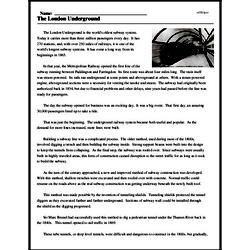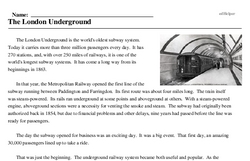The London Underground
The London Underground is the world's oldest subway system. Today it carries more than three million passengers every day. It has 270 stations, and, with over 250 miles of railways, it is one of the world's longest subway systems. It has come a long way from its beginnings in 1863.
In that year, the Metropolitan Railway opened the first line of the subway running between Paddington and Farringdon. Its first route was about four miles long. The train itself was steam-powered. Its rails ran underground at some points and aboveground at others. With a steam-powered engine, aboveground sections were a necessity for venting the smoke and steam. The subway had originally been authorized back in 1854, but due to financial problems and other delays, nine years had passed before the line was ready for passengers.
The day the subway opened for business was an exciting day. It was a big event. That first day, an amazing 30,000 passengers lined up to take a ride.
That was just the beginning. The underground railway system became both useful and popular. As the demand for more lines increased, more lines were built.
Building a subway line was a complicated process. The older method, used during most of the 1800s, involved digging a trench and then building the subway inside. Strong support beams were built into the design to keep the tunnels from collapsing. As the final step, the subway was roofed over. Since subways were usually built in highly-traveled areas, this form of construction caused disruption to the street traffic for as long as it took to build the subway.




